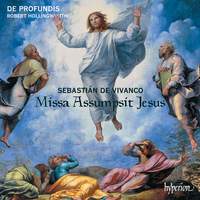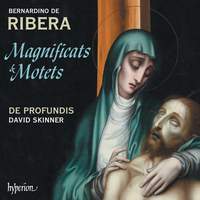Interview,
Robert Hollingworth on Vivanco's Missa Assumpsit Jesus
 Robert Hollingworth is probably best-known as the founder and conductor of I Fagiolini, one of the world's leading early-music ensembles and musical advocates, among many other things, of the 40-part mass Missa sopra Ecco sì beato giorno by Alessandro Striggio rediscovered in the early 21st Century. However, he is no stranger to working with other groups, and June saw the release of his album with Cambridge-based male vocal ensemble De Profundis, showcasing the polyphonic works of the Spanish composer Sebastián de Vivanco.
Robert Hollingworth is probably best-known as the founder and conductor of I Fagiolini, one of the world's leading early-music ensembles and musical advocates, among many other things, of the 40-part mass Missa sopra Ecco sì beato giorno by Alessandro Striggio rediscovered in the early 21st Century. However, he is no stranger to working with other groups, and June saw the release of his album with Cambridge-based male vocal ensemble De Profundis, showcasing the polyphonic works of the Spanish composer Sebastián de Vivanco.
Quite apart from the interesting choice of repertoire, several things about De Profundis's approach to historically-informed performance struck me as innovative and fascinating, and I couldn't resist picking up this often fraught topic with Robert...
What drew you particularly to Vivanco, out of all the Renaissance composers – many far better-known and more frequently-performed?
Well, I'm really part of a team for this recording - the brains behind it is Bruno Turner, a doyen of sacred Spanish Renaissance music. About thirty years ago I was leaving university and looking for my first job, and I ended up working for his company, Mapa Mundi in London, who published some quite recherché Renaissance church music. This was an unusual thing to do at the time - you could either buy anthologies or a few pieces individually, but Bruno set out to make unknown pieces (particularly Spanish sixteenth-century church music) available to choirs at a performing pitch but still in scholarly editions. I've always thought they are the best editions I've ever performed from. I worked for Bruno for three years, and that was my first real exposure to Spanish Renaissance music beyond that of Victoria: Guerrero, Alonso Lobo, Ribera (the focus of the previous De Profundis album on Hyperion). Victoria, of course, worked in Rome and his music was printed there, so it got around a lot more.
This is only the second ever CD dedicated to Vivanco - he's an incredibly fine composer. Palestrina is always quoted as the classic Renaissance composer but in fact he's part of the second generation of composers to use imitative polyphony, in which all the parts are equally important. What Palestrina and Vivanco and other composers do with this is to allow the voices sometimes to speak together clearly in chords so you have a sort of release from this wonderfully democratic, but quite involved polyphony: it’s a wonderful balance. How much this attention to textual clarity is a Council of Trent thing or just a development of musical style is hard to say but the mix of chordal and polyphonic writing is incredibly attractive, and it's so skilfully done. You can see why he had this string of highly-regarded jobs around Spain at the time, because his technique is fantastic: with both Victoria and Vivanco, it's as if the very cloth they're working with is satin or silk of the very finest quality, and that’s quite apart from what they actually do with it.
Vivanco’s music seems at times to owe much more to the Italian school of polyphony – the rhythmic thrust of many phrases recalling Palestrina, for example – than the passionate Iberian school. Do you think he absorbed more of this Roman style than Victoria, Lobo and the other Iberians?
It's difficult to know who to compare him with. If you listen to Morales, who is definitely of a previous generation, or Guerrero who is about half a generation earlier, their music is just fundamentally more polyphonic. Then look at the beginning of O Sacrum Convivium; you get a chord of B flat, D and F sharp on this word 'sacrum' (holy feast), so he's not afraid to colour in the way that Spanish composers are known for doing (you wouldn't really find Palestrina doing something like that!).
He also has a passion for writing canons - but instead of doing what most Renaissance composers did with the Mass, which was to use the second Agnus Dei for this and as a place to use more voices, Vivanco does this with the Hosanna instead. The second Hosanna includes some very complicated canons, as does the final movement of the Magnificat - though no-one's going to hear them! It's not like Tallis's Canon where it's laid out simply: it's an almost inaudible structure. He has such skill, but he's able to use it expressively.
“All very clever”, Bruno Turner's sleeve notes observe of a piece of canonical wizardry that closes the album, “but you will probably just hear a gorgeous sonic tapestry.” Is there maybe more truth in this than some might like to admit? Can polyphony of this kind sometimes be more satisfying to the singers, who can see under the bonnet, than to the listeners?
This is something that’s always fascinated me. I did a show with I Fagiolini back in 2009 called 'Tallis in Wonderland', which was about how people listen to polyphony, and what you could do in a non-regular concert setting to try to put the audience in the middle of it. But I think it's inescapable; one of the great glories of polyphony is that it's not really written for listeners - and I know that's a terrible thing to say in an interview about a new recording but this sort of music is written 'ad majorem Dei gloriam': for the glory of God. And it's not fundamentally an art designed to make texts easier to hear, which is why this later sixteenth-century style that mixes chordal writing and polyphony is so effective in these pieces.
What I tried to do with De Profundis was to allow the parts to have a very strong relationship to each other and really feel the interdependence, rather than the independence, of the lines. A lot of that is to do with enunciation, which is one of the few things that we know they really valued in Renaissance singing; I think it's common for British vocal groups to under-enunciate polyphony because the sound seems to be the most important thing. There is a fundamental Northern European singing trait, and indeed speaking trait, of breaking up your phrases. You can hear it when anyone speaks: there's a comma every five words! Whereas if you were Italian, the sound would continue throughout, which is a kind of legato speaking. So it is more Mediterranean to sing legato than it is Northern European - and to draw the words into that legato was very much part of my job with De Profundis.
It’s quite in vogue at present to strip down the forces for performances of early music – single-voice Matthew Passions being the extreme example. You field quite a large choir, with tasteful instrumental doubling of the bass part on bajon (early bassoon). Is this approach closer to the sound that would have been heard in Vivanco’s time than the unaccompanied solo-voice consorts that we often hear?
I have to tell you how massively uninterested I am in fashion! Fashions come and go. And performing Bach one-to-a-part because of iconography and imagery of performances in Bach’s own time has nothing to do with what they did 150 years before that at the other end of Europe. In the sixteenth century there were choirs and consorts of all sorts around Europe: the idea that there is one way of doing anything in the sixteenth century is completely bonkers. In some choirs they had falsettists on the top line, in some they had boys, in others they had castrati; there’s also a tradition of sacred polyphony performed by women in convents. In some places they would only have had enough money to have a consort of one-to-a-part singers. But we know that in cathedrals in Spain they did have several voices to a part; how many they used for one service, of course, is another matter.
I'm a great believer in 'modern authenticity'. If you look at The King's Singers, for example, who have done some very fine recordings of Spanish Renaissance music, they now have their own authenticity because they've been singing for fifty years: whatever they do now is kind of authentic because they are being themselves. De Profundis is a male-voice choir and perform closer to the likely written pitch than choirs using sopranos, who transpose everything up because some modern directors just like the sound of it up there. There seems to be evidence that Renaissance writers liked singers singing in a comfortable part of their voice (typically in the medium-lower register), but it's unusual to hear Renaissance music performed in this way today.
In an age where authenticity in performance is a highly sought-after ideal, why do you think the readjustment of Renaissance polyphony back to its ‘correct’ pitch has been so slow to take hold?
Firstly, let's be very careful about saying that we 'know' things: we know certain things but there are an awful lot of 'known unknowns'. For example, we know that they started using castrati in Rome for choirs at the end of the sixteenth century, and they had to tune the organs down as a result - presumably because the organs played along, which tells us a couple of interesting things. But we can't say what pitch was used in Salamanca where Vivanco ended up. However, we know that groups such as The Clerkes of Oxenford, The Sixteen and The Tallis Scholars were all heavily influenced by David Wulstan's research back in the 1970s and early '80s and were all performing Tudor music transposed up a minor third, which set off a fad for enjoying the sound that high sopranos make. The Tallis Scholars' recent recording of Taverner's Missa Gloria tibi Trinitas is an incredibly skilful piece of singing and music-making, but at that pitch it seems to involve putting modern altos on ‘tenor’ lines and that changes the balance of the aural make-up which I don’t believe was intended.
So it's not just about pitch per se, but about voice types. There was a wonderful Radio 3 programme about twenty years ago about how to listen to polyphony, and one of the things that was said was that you should try to listen to the middle of the texture; and you can't do that so easily if the thing has been transposed up and the sopranos are high and quite loud, while the middle voices are reduced because the countertenors and altos are naturally weaker in that range than a tenor would have been. It's a very knotty issue and I'm sure there'll be people reading this who disagree, but I do think it's great to listen to polyphony at this lower pitch..
One of the great pitching truths of the sixteenth century comes from the writer who said that you choose your pitch for the Mass in the morning by seeing how low the bass can sing, and you build up from there. To a certain extent, unless you've got organ accompaniment (which was, it's true, probably more prevalent than we would like to think with our purer-than-thou a cappella hats on), then the clefs are no more than things that tell you where the semitones come. One of the pieces where we took just this approach was the eponymous De profundis, with the basses singing right down in their boots: you wouldn't want to hear that up a fourth.
'Missa Assumpsit Jesus' is released at the end of June on Hyperion Records.
Available Formats: CD, MP3, FLAC, Hi-Res FLAC
De Profundis' début album, featuring première recordings of works by the Spanish composer Bernardinus Ribera.
Available Formats: CD, MP3, FLAC, Hi-Res FLAC
Some of the first modern performances of works by Guerrero and Lobo feature on this seminal recording from 1985.
Available Formats: CD, MP3, FLAC
The Tallis Scholars' glorious 40th birthday present to themselves, featuring the soaring polyphonic lines and epic musical edifices of John Taverner.
Available Formats: CD, MP3, FLAC, Hi-Res FLAC, Hi-Res+ FLAC






